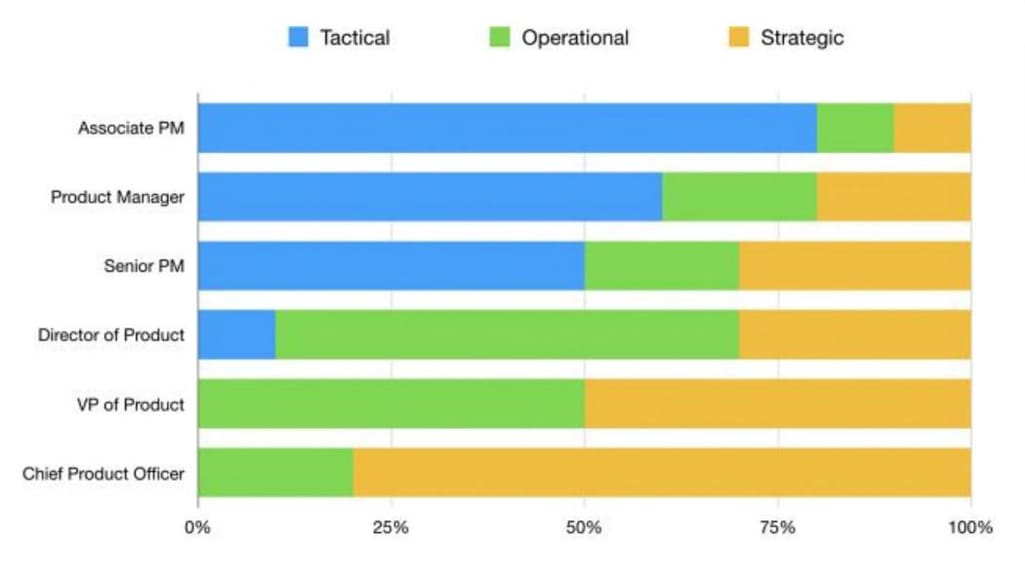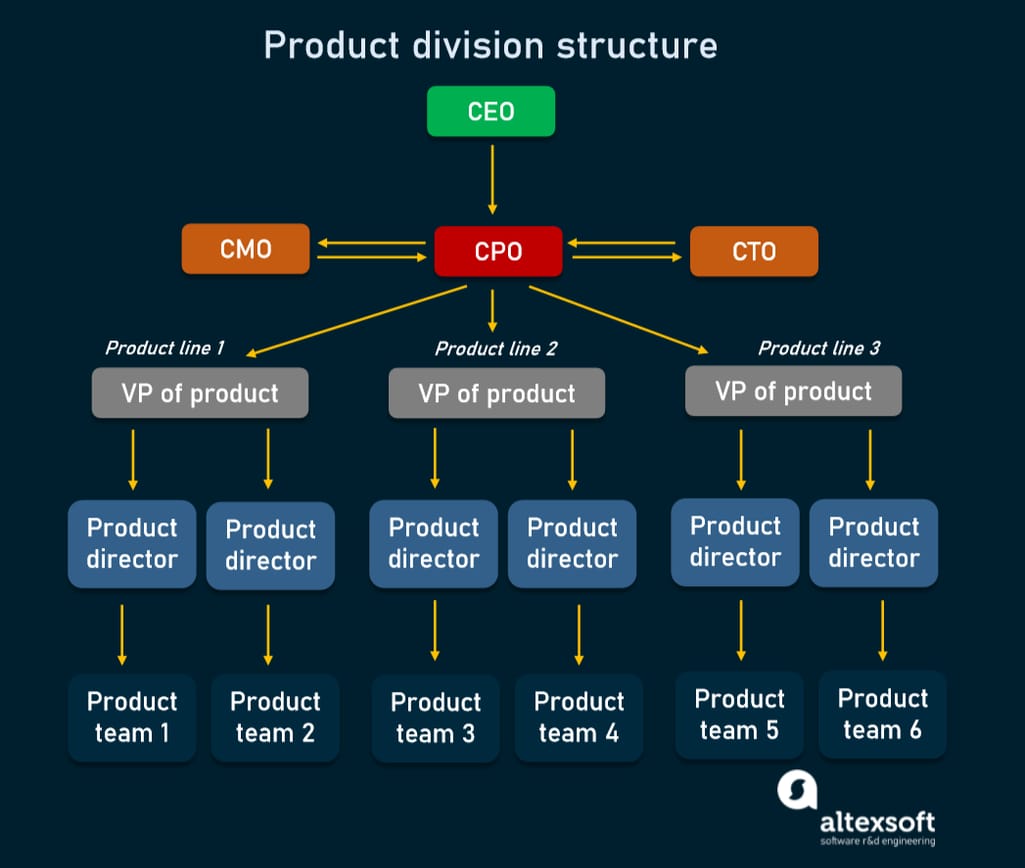Why and when do companies need another C-level executive — a chief product manager or CPO? How does this position facilitate business growth and how is it different from a CTO or VP of Product? What makes a great CPO? And what does it take to find the right person for the job?
All those questions come to mind owing to the relative novelty of the title. While tech giants like Microsoft, Netflix, Uber, Adobe, and others have already expanded their executive benches with CPOs, many companies have only a vague idea about the position.
This article sheds some light on the rising star of the executive board, by explaining its role, responsibilities, and expected contribution to a company’s success.
Who is a Chief Product Officer? Their role and place in a company’s hierarchy
The Chief Product Officer or CPO is the head of the product department who bears end-to-end responsibility for the product portfolio.
The increasing number of CPOs is driven by the explosion of SaaS apps and the evolution of product management as a separate discipline. As product teams become no less significant than engineering and marketing departments, companies see the need for a person who can bring deeper product perspective and start searching for a CPO.
Small companies typically don’t have a CPO and are comfortable with product managers. The position begins to appear as business scales to medium-sized companies, and it’s a must-have for a large tech enterprise, obsessed with delivering great customer experience.
Let’s see how the role and responsibilities of a senior product person change with company growth.
Distribution of tasks in product groups
No matter the company size or the level of management, the activities of a product team fall into three different types — tactical, operational, and strategic. The higher the level, the fewer tactical tasks a product leader solves. Executives in large companies focus on the strategy, leaving daily routine to subordinates.
Strategic, operational and tactical percentages of product roles (for teams of over 10 people). Source: Escaping the Build Trap by Melissa Perri
Tactical activities aim at short-term goals such as building new features and delivering them to customers.
Strategic activities are about looking at the future of the product: what extra value it will bring to customers, how it will differ from competitors, and how it will help your company reach its business objectives.
Operational activities bridge strategy and tactics. That’s where a product roadmap is created to tie the current state of the product to its future.
Product division hierarchy: from associate PM to Chief Product Officer

An example of a product division structure in a large company.
The number of levels in the product team depends on organizational structure and size. But typically, this is what the whole path from the lowest tier to the most senior position looks like.
An associate product manager is an entry-level job, which allows neophytes to step into the product world. As a rule, this position is available only in large companies aiming at growing their own product leaders from the ground up.
A product manager works closely with designers and engineers as well as with the marketing team to deliver a solution that fits customer needs on time. It’s a tough role: The PM must be a strategic thinker to contribute to the crafting of a product vision. But at the same time, they perform many daily operations to guarantee a smooth development process.
A senior product manager does almost the same job as a regular PM. The difference is that the senior PM controls more complex products or even initiates new product lines. This role involves fewer tactics, but more operational and strategic work.
A director of product will be seen at larger companies and is critical for product scaling. It’s the first level of human resource management as contrasted with solely managing products. The product director leads a group of PMs responsible for different features of the same, complex product. Most of the time, he or she works on operational tasks such as creating a strategic roadmap and ensuring the effectiveness of the product team.
A VP or head of product manages the entire product line of a company that has several products and many management layers. This can also be the most senior product person in a startup. VPs don’t interfere with tactics concentrating instead on operations and strategy. They are also responsible for the financial success of their product line.
A CPO oversees the whole product portfolio, being in charge of its growth and the company’s overall product strategy. This executive works with VPs to ensure that all products are aligned with the company’s culture and business goals. The right person for the position is not just an effective manager, but a product evangelist and visionary, capable of spotting trends and setting goals for years ahead.
The CPO works across many functions which often overlap with what other executives are coordinating. To avoid confusion, we’ll look at how the duties of the CPO are separate from the duties of other high-ranking positions.
Chief Product Officer vs Chief Technology Officer vs Chief Marketing Officer: Who manages what?
The CPO works side by side with the Chief Technology Officer (CTO). They share the same goal — the creation of a product that meets and exceeds customer expectations. But their responsibilities differ. The CPO decides what the company should build and why, while the CTO focuses on how to build it in the best possible way. The CPO studies customers, trends and markets; the CTO explores technologies.
The CPO also has to build strong relationships with the Chief Marketing Officer (CMO) who develops the product marketing strategy and controls its implementation. However, sometimes these two roles overlap so much, that companies just eliminate the CMO title in favor of the CPO, capable of uniting technology, product development, and marketing under one umbrella.
Read our article on the fractional CTO role to learn how it differs from full-time and interim CTOs.
Overlaps in functions between CPO, CTO, CMO, and CSO (Chief Sales Officer). Source: Medium
Now, that you have a general idea, it’s time to get into specifics of the role of the CPO.
The CPO responsibilities and essential functions
So, the CPO is the highest-ranking product manager who is expected to align product development with the company’s business strategy and customer needs. To achieve this broad and challenging goal, the CPO takes responsibility for the following tasks and processes.
Developing product vision
Product vision reflects the core value and mission of the company’s offering. It explains how the product will impact the lives of customers and, globally, how it can change the world for the better.
Some popular product vision statements are
“to create innovative technology that is accessible to everyone and that adapts to each person’s needs.” (Microsoft)
“to build a place where people can come to find and discover anything they might want to buy online.” (Amazon)
“to provide access to the world’s information in one click.” (Google)
“to create economic opportunity for every member of the global workforce.” (LinkedIn)
“smarter transportation with fewer cars and greater access. Transportation that's safer, cheaper, and more reliable; transportation that creates more job opportunities and higher incomes for drivers.” (Uber)
Developing a product strategy
To realize their vision, companies need a long-term plan or product strategy that outlines how exactly they are going to turn concepts into a sustainable product that will drive profits. The strategy considers inner resources of the organization as well as external factors — business climate, competition and, of course, customer needs. It connects the vision and financial outcomes, assisting in making daily decisions.
Product development strategy: from vision to roadmap. Source: This is Product Management
Building product vision and strategy is one of the CPO’s critical responsibilities. It requires a deep understanding of users and their requirements, the ability to see the big picture and passion for delivering innovative solutions.
Managing cross-functional teams
To create a winning solution, a company has to coordinate efforts of employees from various functional areas: software engineers, product managers, UX/UI designers, analytics and marketers. It’s up to the CPO to lead these separate groups to the common goal, clearly communicating the company’s vision of the outcome to employees with different backgrounds.
In a way, the CPO acts as a mini-CEO who orchestrates processes across multiple departments and coordinates principals like the Head of the UX Department, VP of Product, Director of Product Marketing.
Product marketing and evangelism
The CPO is a key person in product promotion and sales, the executive responsible for a product's constant refining so that it continues to appeal to loyal customers and attract new ones.
To make the right marketing decisions, the CPO uses product analytics data, communicates with salespeople, and studies customer feedback. The executive also takes part in presentations of the product during exhibitions, conferences, meetings, and other events. The CPO delivers speeches explaining the value and mission of the product to the broad audience.
Continuous customer research and product analysis
The leader of the product division initiates and supervises various types of customer research to get insights into their practical needs and emotional desires. Research data is used to plan improvements and differentiate the product from its competitors.
The CPO also aligns plans and strategies with product performance metrics (KPIs), which reflect revenue as well as customer growth, engagement, and retention.
CPO functions can vary from company to company, but to perform them an extensive educational and professional background is required.
Chief Product Officer background: Where do they come from
The path to becoming a product lead starts with getting a solid education, typically business- or tech-related. And though the tech background is not mandatory, it’s very helpful for grasping engineering concepts.
For example, Netflix’s CPO Greg Peters holds a degree in physics and astronomy from Yale University. While Scott Belsky, the CPO at the Adobe Creative Cloud, received a bachelor’s degree in economics and entrepreneurship at Cornell University and later got his MBA at Harvard Business School.
Typically, CPOs work their way up to the executive board from a product manager role, progressing through all stages of the career development — senior PM, product director, VP of product. So if an organization has talented product leaders, they can be logically promoted to the CPO position.
Sometimes the position is taken by CTOs, CEOs (in smaller companies), or serial startup founders. Anyway, preferred candidates usually have 10+ or even 20+ years of experience in building new products — often across different industries.
The following table illustrates typical career paths for CPOs working in global tech enterprises.
Backgrounds of CPOs in leading tech companies.
What makes the great Chief Product Officer: competencies and personal qualities
Good education and immense product-related experience are must-haves, yet not sufficient to succeed in the CPO role. Below is the list of competencies and personal traits most critical for the C-level position.
Leadership. Briefly, leadership is the ability to influence and motivate other people so that they maximize their efforts towards achieving the company’s business purposes. As a product leader, the CPO unifies groups with different backgrounds, creating a sense of mutual goal.
Communication. Effective CPOs are always great communicators. Their mission is to get out a clear message about the value of the product to executives, product teams, and customers. The success of the solution heavily depends on the ability of the CPO to inspire everybody with the product vision.
Strong customer focus. “When I sit down to think about a product, the center of it is the user. The center of the experience is the promise to the customer,” Tinder CPO Brian Norgard reveals. The product leader looks at the solution from the perspective of its value for users and makes better customer experience the number one priority.
Business acumen. Successful products not only satisfy customers but also generate massive revenue. Business acumen means that a person can quickly evaluate the situation in the market and identify profit opportunities.
Structured thinking. This is the ability to break down broad goals and long-term strategies into manageable tasks.
Strategic thinking. While most people focus on what is directly ahead, strategic thinkers envision what may happen in the future. They look across different industries to see the big picture, analyze large volumes of information to spot trends, and offer new approaches to old problems.
Strategic thinking allows product leaders to anticipate customer needs and wishes — before they appear. As Panos Panay, CPO at Microsoft’s Device Group, urges, “Let’s give our customers products that help them get where they are going. Maybe they don’t know where that is… So let’s make products for when they get there.”
Creativity. Very often, the CPO faces challenges that don’t always have clear-cut answers. So, this role requires the ability to be creative in forging unconventional methods.
Enthusiasm and resilience. The ideal CPO is enthusiastic about digging deeper into the problem and recommending the best way to address it. Moreover, he or she transmits this enthusiasm to other people. But if something doesn't work as planned, the CPO must be resilient enough to keep moving forward and finally find the right decision.
When does a business need a Chief Product Officer?
In startups and small companies, the role of a product evangelist is successfully performed by the CEO, CTO, or both. The need for a CPO may arise when an organization starts to develop the second product, expands into new markets, or merges with another company. The C-level person is to oversee the entire portfolio, ensuring that all solutions work in harmony to achieve business objectives.
A strong product leader in the C-suite drives the success of product companies and helps them win leading positions in the market. The bad news is that there are not too many “off-the-shelf” CPOs available for hiring as the role is still evolving. But you can always try to bring up the head of the product division within your organization. And, it's always best to be proactive and get ready for growth.

